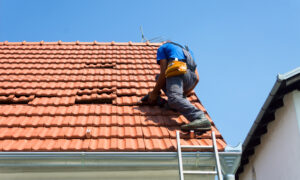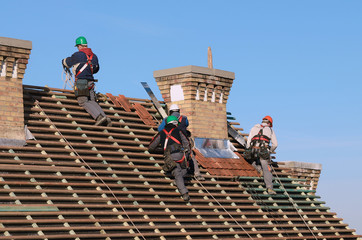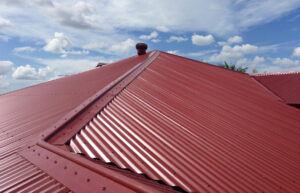Roofers are experienced at working on the roofs of buildings. They install, repair, and inspect roofs to protect the interior of structures from weather elements and water leaks.

Roofing contractors must stay up-to-date on all city, state, and federal regulations pertaining to re-roofing projects. Generally, this includes having the proper licensing, insurance, and bonding.
Roofing contractors provide numerous services related to the replacement of residential and commercial roofs. This can include determining the scope of work and the appropriate materials, as well as helping guide projects through the permitting and inspection stages. A roofing contractor may also assist with negotiating the terms of a contract. For example, they can help negotiate the amount of time the contractor has to complete the job and how much the homeowner should expect to pay for cleanup and disposal services. Typically, this is one area where general contractors are not the best option for a re-roofing project because they don’t specialize in any single field of construction.
Using an experienced roofing company can save you a lot of time and headaches. They will be able to handle all aspects of the roof installation process and can give you a fair estimate for the cost of the project. Additionally, they will be able to deal with unexpected issues that may arise during the project.
In addition to providing these services, roofing contractors can also offer assistance with a variety of other construction-related tasks. For example, they can assist with replacing flashing—the material around chimneys and where roofing planes meet—to prevent leaks. They can also replace or repair shingle vents and dormers to keep rainwater from entering the home.
A quality roofing contractor will also have the proper equipment and manpower to get a job done quickly. They can also perform an inspection and recommend any necessary repairs to protect your investment. Additionally, they can make recommendations for other roofing-related projects, such as roof insulation or solar panels.
The roof of your house is a crucial part of the structure and should be inspected regularly to ensure that it is doing its job. This includes examining the structure of the roof, which can be difficult without special equipment. Depending on the type of roof, there are many different things that can go wrong, including cracks in the asphalt shingles, water intrusion in the underlayment, and the deterioration of the flashing.
Repair
The roof of a building is an essential component of the structure, protecting it from rain, snow, sunlight, and heat. Roofing services install, repair, and inspect the roofs of buildings, homes, and businesses to keep them safe from weather damage. They may also perform energy efficiency upgrades to a home’s insulation to reduce utility bills and improve indoor comfort.
One of the most common roofing problems is a leaky roof. Water can wreak havoc inside a home or business, causing structural damage and encouraging the growth of toxic mold. Roofing services can repair leaking roofs, replace damaged or missing shingles, and perform other repairs to keep water out.
A well-maintained roof is also important for curb appeal. A pristine roof can make a house or business more attractive and enticing to potential buyers or tenants.
Before hiring a roofing company to repair your roof, ask them for references from previous customers. Also, look for online reviews and testimonials. Also, check whether the roofing contractor is licensed and insured. Moreover, ask them to provide a warranty for their work.
When you get a quote, be sure to get all the details in writing, including the cost, timeline, and any other terms. Then, compare quotes from several companies to find the best deal. Lastly, ask about any rebates or discounts that are available for roofing services.
In addition to repairing leaks, a roofing service can also do maintenance to help prolong the life of your roof. They can install ridge vents and vented soffits to improve attic air flow and prevent moisture buildup. They can also add or replace flashing, which is the metal that’s placed around chimneys and where roofing planes meet.
A reputable roofing service can repair or replace gutters, downspouts, windows, and siding. They can also repair or replace the foundation of your home, if necessary. In addition, they can help you choose the right type of insulation for your home and climate, as well as install it correctly. They can even do other energy efficiency upgrades to your home, such as adding solar panels or upgrading the heating and cooling systems.
Maintenance
Roofing services include the installation, repair, and maintenance of roofs on residential and commercial buildings. Roofing is the outer covering of the building that protects it from rain, snow, heat, sunlight, and wind. Roofing materials are typically made from wood, metal, plastic, or a combination of these materials. Roofing services also design roofs to meet the needs of each building. Whether the roof is flat or shingled, it should be designed to withstand the local climate and weather conditions.
Roofing service companies can repair leaky roofs and replace damaged or missing shingles. They can also install insulation, which will help keep the home cooler in the summer and warmer in the winter. This will save on energy bills and make the house more resistant to weather damage. Roofing contractors can also advise homeowners on the best type of roof for their homes, taking into account the local climate and age of the house. A well-maintained roof can also add value to the home and increase its resale value.
When hiring a roofing company, it is important to choose one that is licensed and insured. This will ensure that the contractor has the skills and knowledge to complete the job correctly. Licensed contractors should be able to provide proof of workers’ compensation and liability insurance. In addition, they should be able to provide references from past customers.
It is also important to get a written estimate before hiring a roofing company. This will help both parties understand the cost of the job and avoid any surprises later on. The estimate should include the price of the materials, the labor cost, and any other fees or expenses. Lastly, the estimate should also include a detailed timeline of when the work will be completed.
Roofing is a dangerous job, and it can be easy to make mistakes without experience. Even a minor mistake can lead to costly repairs or even a full roof replacement. Roofing services are trained to get the job done safely and quickly, so you can rest assured that your home is in good hands.
Inspection
The inspection process involves a detailed evaluation of the structure by an experienced professional. A thorough inspection can reveal structural problems such as damage, rot, and pest infestations that may not be easily apparent. The inspector will also check for potential electrical issues, plumbing problems, and safety hazards. It is important that all the major components of a building are accessible for inspection. Ensure that all light bulbs are working and that smoke and carbon monoxide alarms are functioning properly. Prune trees and shrubbery before an inspection to reduce the chance of branches falling on the roof or blocking a window or vent.
Many roofing issues stem from a poorly maintained or deteriorated roof system. This includes weakened, missing, or improperly attached shingles; a condition that allows water to enter the home; and cracked and damaged mastic around the vents, skylights, and wall/roof junctions. The inspector will note these areas and recommend appropriate repairs or maintenance.
The inspection will also look for leaky windows and doors; poorly insulated attics; loose, cracked, or broken gutters; and the general condition of the roof and deck or sheathing. The sheathing is the surface, usually plywood or oriented strand board (OSB), to which roofing materials are applied. If the sheathing is rotting or damaged, it should be replaced as soon as possible to avoid damage to the insulation and interior of the home.











